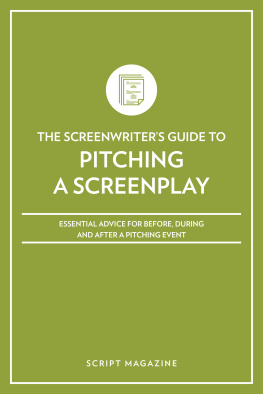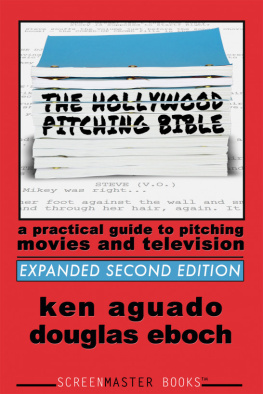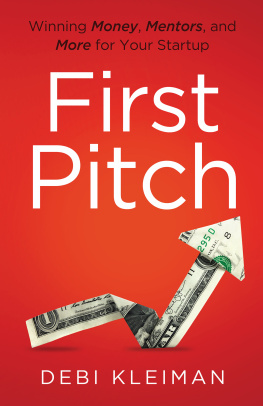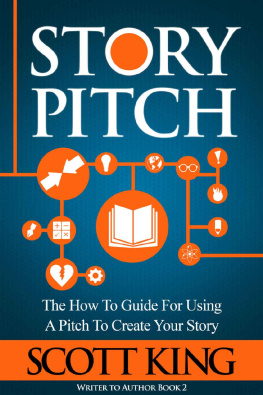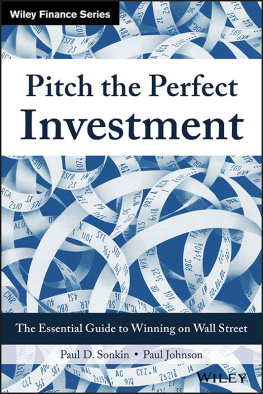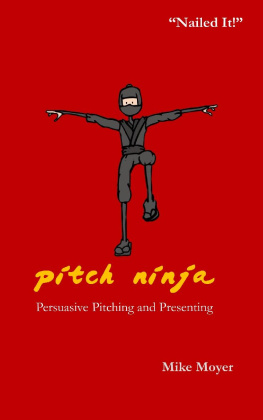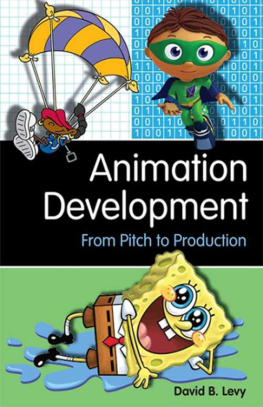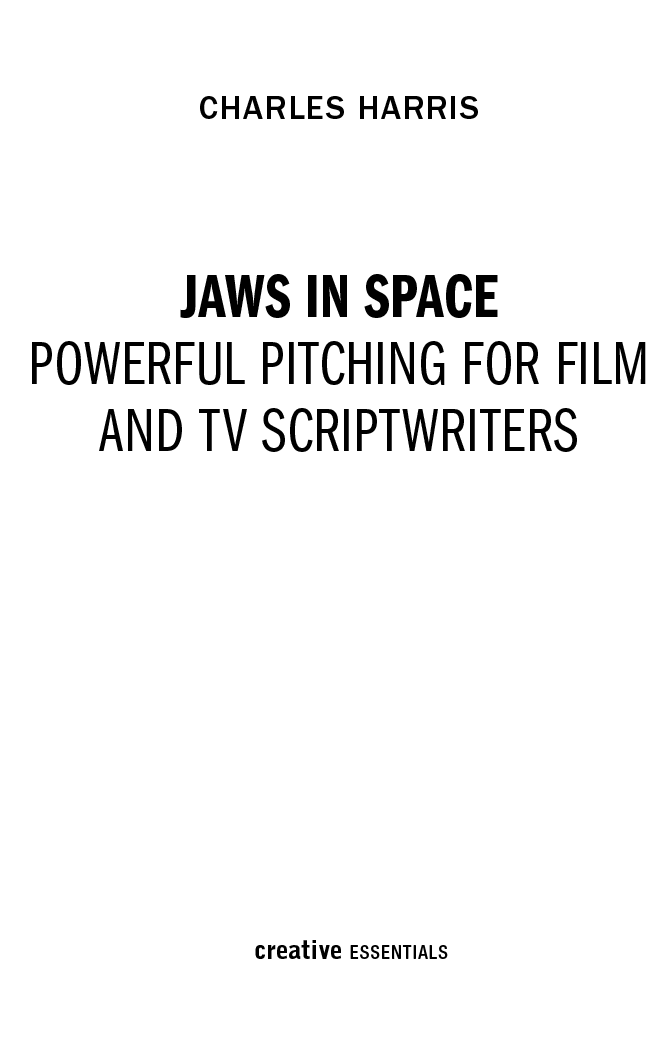JAWS IN SPACE
Two screenwriters once walked into a Hollywood producers office and said three words Jaws in space. Those three words won them the contract for the blockbuster movie Alien .
The ability to pitch well is essential for all writers, directors and producers in cinema and TV. Strong pitching skills will accelerate your career not only helping you sell your projects, but also developing them in the first place, focusing on what makes a story work, clarifying character and plot, and working more successfully with industry collaborators.
This book takes you from the essentials of what makes a good pitch to advanced skills that will help you in all kinds of pitching situations. Charles Harris gives a clear-sighted view of how pitching works in the industry and a series of very practical techniques for developing a gripping and convincing pitch. Drawing on his experience, he examines the problems that can arise with both mainstream and unconventional projects from a range of different cultures and explains how to solve them. He also analyses the process of taking a pitch meeting and shows you how to ensure you perform at your best.
ABOUT THE AUTHOR
Charles Harris is an award-winning writer-director for cinema and TV. With fellow professionals he co-founded the first ever screenwriters workshop (now Euroscript) and teaches writers and film-makers from all over the world. He created Pitching Tuesday for the London Screenwriters Festival and his book Teach Yourself: Complete Screenwriting Course is recommended reading on MA courses
To everyone Ive pitched to
ACKNOWLEDGEMENTS
This book builds on the chapters on developing your premise and marketing your script in my book Teach Yourself: Complete Screenwriting Course and Im very grateful to Jonathan Shipley and John Murray Learning for their permission to use those parts which overlap.
Many people have contributed to this book as I learned my craft over the years, far more than I can mention here. But I do specifically want to thank Phil OShea, Shelley Katz, Anita Lewton, Naz Sadoughi, Paul Mendelson, Eve Richings and Ulrike Kubatta for sharing their experiences. Karol Griffiths for her support. My colleagues at Euroscript and the participants of my pitching workshops around the world, who have helped make this book what it is through their intelligent questioning and professionalism. My gratitude also goes to my agent, Julian Friedmann, his contracts manager, Resham Naqvi, as well as Ion Mills and Hannah Patterson of Kamera Books for asking me to write this in the first place.
Most importantly of all, I must thank my wife, Elaine, for her patience when faced so often by my closed study door over the last months, along with our cats, Chloe and Sasha, who are the only ones who can persuade me to open it.
INTRODUCTION
Once upon a time, the story goes, two writers walked into a producers office in Hollywood and sold a script by saying just three words: Jaws in Space. That script was to become the blockbuster movie Alien , and that moment has passed into Hollywood mythology as the perfect pitch.
I call pitching the great accelerator. The ability to pitch well is essential for anyone who wants to speed up their career as a writer, producer or director in cinema or TV anywhere in the world. Indeed, today the pitch is becoming increasingly important for all artists, including novelists, journalists and playwrights.
Pitching will not only help sell your ideas but develop them in the first place. It helps you clarify character and refine plot. It makes it easier to collaborate with others. Every good writer, director and producer I know is excellent at pitching.
However, there are also many myths about pitching. One is that to pitch is to put on an act to distort the work of the true artist. In fact, good pitching means being true to yourself, your own culture and values. Ive taught writers, directors and producers from all over the world to pitch successfully while staying true to themselves. In this book, youll learn how to pitch powerfully as yourself, whoever you are and wherever you come from.
The content is based on my own experience as an award-winning writer-director and from teaching hundreds of writers and filmmakers over the years. It combines solid content with personal stories from my own career and from fellow industry professionals.
Whatever your goal in film or television (or elsewhere in the arts) Jaws in Space will take you through the process of creating a professional pitch from beginning to end. Youll find a series of practical techniques and exercises, from how to develop a compelling log line to advanced skills that will help you in all kinds of pitching situations. Youll learn the special requirements for pitching multi-stranded films, TV series and documentaries. Then well follow through the process of taking a pitch meeting and discuss powerful ways of ensuring you perform at your best whether presenting to a single person or a large audience.
It will also give guidance as to how you can continue to develop your skills as your confidence grows.
This book grew out of the segments on developing your premise and marketing your script in my earlier book Teach Yourself: Complete Screenwriting Course . Jaws in Space , however, also contains material that is not in the first book, with room to dig deeper into important areas that had to be left out before. And when youve worked through Jaws in Space , youll find that Teach Yourself: Complete Screenwriting Course will take you forward, through the process of writing the treatments youll need, developing character and structure, writing a new screenplay or series proposal and editing it to a high standard. Indeed, if you seriously want to become adept at creating scripts, whether as a writer or as someone who works with writers, I suggest the two books will work very well together.
THE ART OF THE PITCH
Where does pitching come from? People have been pitching to each other for thousands of years well before the first Stone Age artists talked their friends into helping out with the latest cave painting. Humans have long used spoken language to convince, persuade and avoid nasty consequences.
Literary agent Julian Friedmann believes film pitching as it now exists developed around the mid twentieth century. At that time, the Writers Guild of America was so powerful in Hollywood that no screenwriter would write a proposal for a studio without being paid. So, to save money, a producer might wander down to where the writers were working and ask them to tell him a story on the spot. Over time, both writers and producers became skilled at telling and listening to shortened versions of future scripts.
However pitching came about, beware of another myth. This is the scene in the movies where a writer pitches his new script to a studio exec. He describes the opening, in glowing terms. Draws the executive into his world. Widens his hands as he moves into the main story, holds the man spellbound for ten or fifteen minutes as the strands interweave
This is not the reality.
The good and bad news is that nobody has ten or fifteen minutes to weave their pitch. The most important part of your pitch is the first sentence the first two at the most. Its whats known in the business world as the elevator pitch for when you meet your target in a lift and have to pitch in the time available before he steps out at the next floor. In the industry, its also known as your log line or premise .


